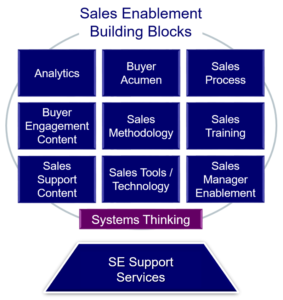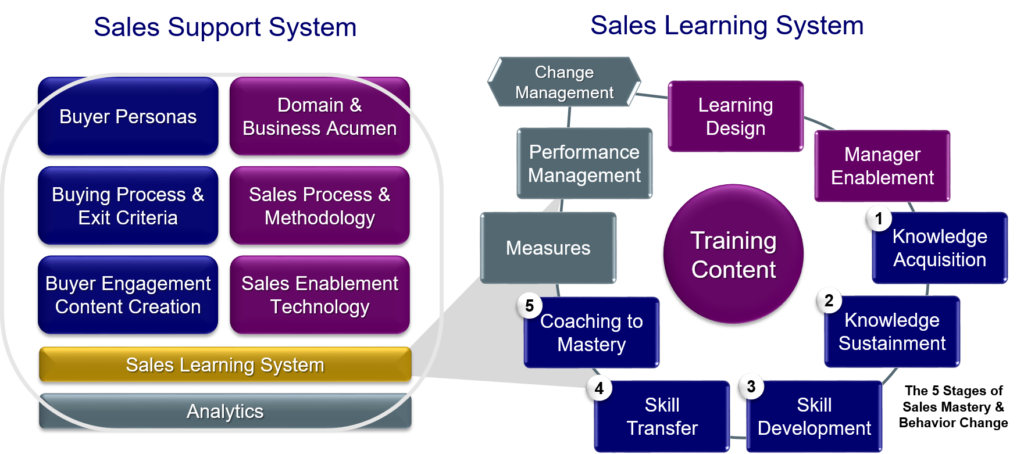Sales enablement has become mission-critical to businesses. As part of the Highspot “Hot Shots” series, today we’ll hear insights from Mike Kunkle, a highly respected sales transformation architect and internationally recognized sales training and sales enablement expert. He has spent 24 years as a corporate leader and consultant, helping companies drive dramatic revenue growth through his best-in-class learning strategies and effective sales transformation methodologies. Today, Mike is the VP of Sales Transformation Services for Fast Lane Digital (a new division of Fast Lane Consulting & Education Services) and founder of Transforming Sales Results, LLC.
What do you see as the most critical aspect of sales enablement and why?
It’s difficult to single out one thing, but if I had to choose only one, I would say the most critical aspect of sales enablement is to improve sales productivity, defined as “revenue per sales producer.” To paraphrase something Greg Alexander once said, “Anything else is just noise.”
To me, this is the “why” of sales enablement: Improve sales productivity. What’s interesting, though, is that there are other critical aspects of sales enablement that fuel growth and produce the improvement in productivity. These are the “How” elements, and unfortunately, I don’t frequently see these in place. Here are just a few examples of the ones I think are critical to producing results:
- The first is what I call “Buyer Acumen,” or having a deep understanding of your primary buyer personas and fostering an outside-in mindset with a laser focus on your buyers. This would include the challenges they face, the problems they’re trying to solve, how they are measured and the metrics that matter most to them (the outcomes they want to achieve), their decision process and decision or exit criteria, and more. If you want to remove what I call “selling by superstition,” or blindly doing the same things each time in different circumstances hoping it will work, get your sales force focused on buying process exit criteria. These are the things that each buyer/decision maker needs to see, hear, feel, understand, and believe, in each stage of their buying process, to feel comfortable moving forward to the next stage with you.
- Another critical aspect is the ability to collaborate across functions and align around initiatives that will produce improvements in sales productivity. In many organizations, there is way too much firefighting, knee-jerk reacting, and flavor-of-the-month thinking, and way too little critical thinking, problem-solving, and logical decision-making. If you don’t have a documented, agreed-upon strategic plan and an aligned, prioritized tactical execution plan, it will lead to the same firefighting and order-taking in sales enablement functions. This leads to running in circles or as the old saying goes, moving the deck chairs around on the Titanic. I hear the Sales Enablement Society leaders refer to this as “random acts of sales enablement.” It’s true, and it’s a distraction from our true purpose of improving results.
- A third aspect is a scientific, diagnostic approach toward organizational performance improvement. There is a wider world of business performance improvement that has come before us that the sales profession largely ignores. There are TQM, Six Sigma, Lean Sigma, Organization Development, Organization Behavior, Organization Effectiveness, Human Performance Technology (HPT), and Performance Consulting. These disciplines have a foundation of assessment, diagnostics, gap analysis, root cause analysis, and general problem-solving thinking and methodology. Yet in sales enablement (and business in general), we often run off to go develop messaging or implement training that may not be the best solution to the problem at hand. We need to work to stop this.
- The last I’ll mention here is an understanding that sales enablement is really change management. If you’re going to produce a different result, it often requires systems thinking and certainly requires the ability to lead and manage organizational and behavior change projects. This includes the focus and staying power to stick with a performance intervention until the change has cemented in the culture and becomes “the way we do things around here.”
What are your key performance indicators for sales enablement — how do you determine success?
In terms of KPIs for sales enablement, I believe the first and foremost is general sales productivity, or revenue per sales producer. The rest can be contextual and nuanced, based on the business and we should look at lead and lag indicators for both learning and performance. Some examples to consider include:
- Time to onboarding milestones and first sale for new hires
- Time to new-hire productivity (minimum acceptable performance)
- Certification times, average scores, and correlation to performance
- Quota attainment
- Sales process conversion ratios
- Pipeline size (2X, 3X, or whatever is required based on your conversation ratios)
- Deal size
- Deal velocity
- Win rates (win, loss, no decision)
- Turnover rates
There are plenty of others (and you can see a few more in slides 19-20 of this deck), which is why you should choose the ones that make the most sense for your individual situation.
What three trends do you see today in sales enablement processes and technology?
Aside from an increasingly flooded market of sales software, apps, and tools of all types, here are some things I’m seeing and hopeful about:
- A broadening of features in solutions: there are still a massive number of niche players, and it’s possibly the only way to enter the market unless you have unlimited funding and a long stealth ramp, but I’m seeing more companies try to solve multiple problems, which reduces the need to stitch together a “Frankenstack” monster to support learning and sales performance for your sales force. Whether by broadening the feature set internally, or working to create a partner ecosystem to plug holes, I see progress here and believe savvy buyers will soon demand broader, if not total, solutions, across the entire sales performance ecosystem or customer lifecycle (or, at a minimum, be able to piece a full solution together with no more than 2-3 vendors whose broader solutions cover all needs).
- A focus on AI and machine learning: You almost can’t turn around now without hearing someone talk about artificial intelligence, natural language processing, machine learning, deep learning and more, especially about the applications for marketing and sales.
- Technology-enabled workflow performance support: “Electronic performance support systems” have been talked about since the eighties, and job aids have been around for far longer, but I’m starting to see more examples of technology-enabled workflow performance support in play now, guiding sales reps to incorporate what they were taught, or best practices, into their workflow. Yes, digital sales playbooks are included in this category, but it includes far more, ranging from the support for using apps effectively (with GuideMe and WalkMe, as examples) to guiding reps to use effective opportunity management or strategic account management practices (with Membrain and Revegy, as examples).
How do sales enablement processes change the way organizations market and sell?
Done well, sales enablement increases the focus on what matters to your buyers. It details what Marketing and sales reps need to do and say to most effectively engage with those buyers to understand their challenges/opportunities, and resolve/enable them, in ways that provide value from the buyers’ perspective. This has always been the great paradox of selling (if not life in general). You achieve your goals by helping others achieve theirs.
The rest of the answer to this question is already embedded in previous questions.
What advice do you have for someone who is looking to modernize/enhance sales enablement processes in their organization?
 Get a charter in place. Consider what I refer to as the “building blocks” of sales enablement (and whether you can offer support services, such as account research, presentation development, RFP support, deal desk, coaching, or others).
Get a charter in place. Consider what I refer to as the “building blocks” of sales enablement (and whether you can offer support services, such as account research, presentation development, RFP support, deal desk, coaching, or others).
Determine — with your available budget, staffing, and level of executive sponsorship — how you will define sales enablement in your organization and gain alignment from stakeholders and those you’ll collaborate with to get results. Basically, develop a sales enablement business plan.
Consider taking a systems approach to sales enablement. As a function, sales doesn’t exist in a vacuum. Daniel Kim, co-founder of both Pegasus Communications, Inc. and the MIT Center for Organizational Learning, defines a system as “any group of interacting, interrelated, or interdependent parts that form a complex and unified whole that has a specific purpose.” He continues to add, “The key thing to remember is that all the parts are interrelated and interdependent in some way. Without such interdependencies we have just a collection of parts, not a system.”
For my purposes, in organizational effectiveness and sales performance improvement work, I define systems thinking as a method of critical thinking where we analyze the relationships between the parts of a system to understand it more fully to make better decisions about how to improve its performance and, therefore, business outcomes.

These systems require more discussion than space allows here, but I’m sure you can see how things entwine to better support sales performance. For more detail, you can watch a recorded webinar on the Sales Learning System and 5 Stages of Sales Mastery and Behavior Change, or view this conference presentation on the four systems I work with most frequently (it’s an earlier version of the Sales Learning System, but you’ll get the idea).
Learn more about Mike Kunkle at https://www.mikekunkle.com.




